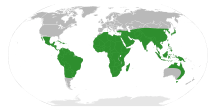Ingeae
| Ingeae | |
|---|---|
.jpg) | |
| Pacay (Inga feuillei) | |
| Scientific classification | |
| Kingdom: | Plantae |
| Clade: | Angiosperms |
| Clade: | Eudicots |
| Clade: | Rosids |
| Order: | Fabales |
| Family: | Fabaceae |
| Subfamily: | Mimosoideae |
| Tribe: | Ingeae |
 | |
| The range of the tribe Ingeae. | |
Ingeae is a tribe of leguminous plants in the subfamily Mimosoideae of flowering plants in the pea family. They are neotropical trees and large trees in the legume family (Fabaceae). They grow from Mexico to Argentina. Most of the species can be found in the Amazon Basin and the Guyana Highlands. They have a deep-green fernlike foliage, with bipinnately compound leaves. Some species have lauroid type leaves. Some are spiny trees and shrubs found in subtropical and tropical regions of the Americas. The ripe pods eventually fall to the ground and are eaten by various mammals, thereby dispersing the seed.
Some Ingeae species are used for their hard wood, in others that are widely cultivated, the fruits are legume pods that contain large amounts of sugar and are edible. Others are used as ornamental trees in gardens. The seeds of some species are used as animal and human food.
Taxonomic history
Britton & Rose (1928) divided the Ingeae into several smaller genera based on stipule characteristics, inflorescence type, leaf texture, mode of legume dehiscence, form of the fruit, and the presence of a seed aril.
Genera
|
|
|
|
References
- ↑ "Chloroleucon (Benth.) Britton & Rose". Germplasm Resource Information Network. United States Department of Agriculture. 2006-12-14. Retrieved 2009-07-13.
- ↑ "Samanea (DC.) Merr.". Germplasm Resource Information Network. United States Department of Agriculture. 2005-02-10. Retrieved 2009-07-13.
- ↑ "Genera of Fabaceae tribe Ingeae". Germplasm Resource Information Network. United States Department of Agriculture. Retrieved 2009-07-13.
| Wikimedia Commons has media related to Ingeae. |